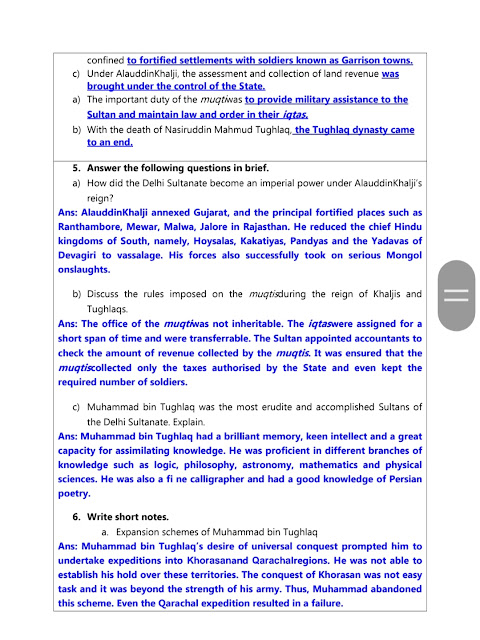Towns,
Traders and Artisans
Q1. What were the textiles of Surat famous
for?
- The textiles of Surat were famous for
their gold lace borders (zari) and had a market in West Asia, Africa and
Europe.
Q2. What was the significance of Surat
hundis?
- Surat hundis were honoured in the far-off
markets of Cairo in Egypt, Basra in Iraq and Antwerp in Belgium.
Q3. Where is Hampi located?
- Hampi
is located in the Krishna-Tungabhadra basin, which formed the nucleus of the
Vijayanagara Empire, founded in 1336.
Q4. Name the spices which became part of
European cooking.
-
Spices grown in tropical climates (pepper,
cinnamon, nutmeg, dried ginger, etc.) became an important part of European
cooking.
-
Q5. Why did
the rulers endow temples with grants of land and money?
-
They endowed
temples with grants of land and money to carry out elaborate rituals, feed
pilgrims and priests and celebrate festivals.
Q6. From
where did the Gujarati Traders imported spices, tin, Chinese blue pottery and
silver?
-
Gujarati Traders
imported spices, tin,
Chinese blue pottery and silver from Southeast Asia and China.
Q7. Why
both the Dutch and English East India Companies attempted to control
Masulipatnam?
-
Both the Dutch and English East India
Companies attempted to control Masulipatnam as it became the most important
port on the Andhra coast.
Q8. Write a
brief note about Murshidabad.
-
Murshidabad (West Bengal) on the banks of the
Bhagirathi, which rose to prominence as a centre for silks and became the
capital of Bengal in 1704, declined in the course of the century as the weavers
faced competition from cheap mill-made cloth from England.
Q9. What
kind of market did the small towns have?
-
They usually had a
mandapika (or mandi of later times) to which nearby villagers brought their
produce to sell. They also had market streets called hatta (haat of later
times) lined with shops. Besides, there were streets for different kinds of
artisans such as potters, oil pressers, sugar makers, toddy makers, smiths,
stonemasons, etc.
Q10. What
was the system of advances? How did it affect the life of Weavers?
-
Crafts persons
began to work on a system of advances which meant that they had to weave cloth
which was already promised to European agents. Weavers no longer had the
liberty of selling their own cloth or weaving their own patterns. They had to
reproduce the designs supplied to them by the Company agents.
Tribes and Tribal
Societies
Q1: What was the religion of the Ahom state?
-
Originally, the Ahoms worshipped their own
tribal gods. But gradually they adopted the Vaishnava faith, then prevailing in
the Brahmaputra valley. The kings granted land to the temples and Brahmanas. In
the reign of Sib Singh (1714-1744), Hinduism became the predominant religion.
But the Ahom kings did not completely give up their traditional beliefs after
adopting Hinduism and kept a harmonious balance by also preserving their
ancestral religion.
Q2: State some characteristics of the tribal societies?
-
The main characteristics of the tribal societies are as follows:
Tribal
societies are united by kinship bonds.
There
is no hierarchy among men and groups in tribal societies.
Strong,
complex, formal organisation are absent in tribal societies.
Tribal
societies have communitarian basis of land holding.
Q3: Who were Mongols? What was the basis of military and
administrative systems of Mongols?
-
Mongols were the best-known pastoral and hunter-gatherer tribe in
history. The basis of military and administrative systems of Mongols was the
support of different ethnic and religious groups.
Q4: Explain
the term 'khel' in reference to Ahom society.
The Ahom society was divided into different clans or khels
on the basis of their specifically assigned occupation and their hereditary
status. The Khels were assigned to different officials at different orders of
gradation. Membership to a particular khel signified that they were the
descendants of a common ancestor. A khel often controlled several villages. The
smallest unit of khel contains 20 paiks. This smallest unit is controlled by an
officer known as Bora.
Q6: What is 'shifting agriculture'?
-
Trees and bushes in a forest area are first cut and burnt. The
crop is sown in the ashes. When this land loses its fertility, another plot of
land is cleared and planted in the same way. This is called shifting
agriculture
Q7: Who are nomadic pastoralists?
Nomadic
pastoralists are the people who travel long distances with their animals in
search of fodder. They live on milk and other pastoral products. They also
exchange wool, ghee etc. with settle communities for grain, cloth, utensils and
other products.











































































































































































































